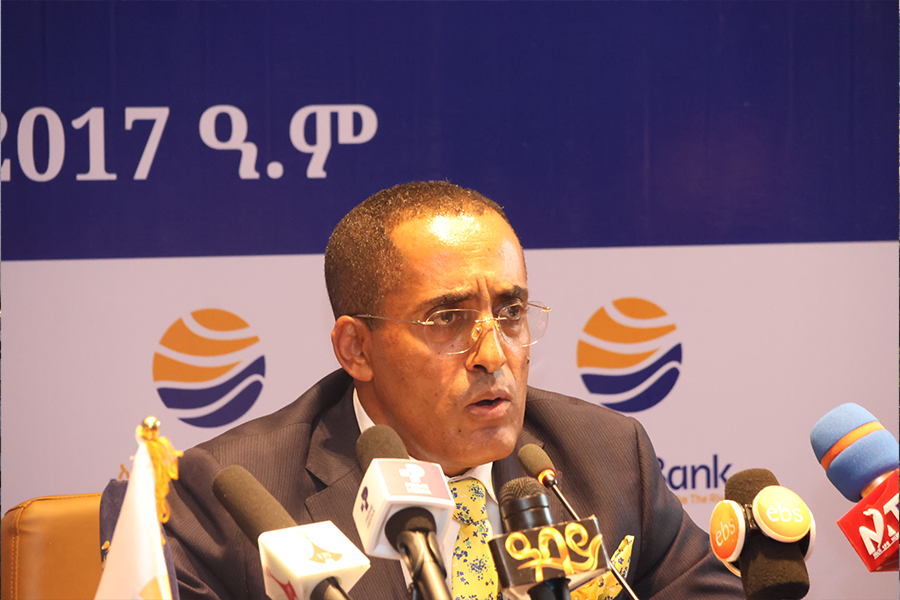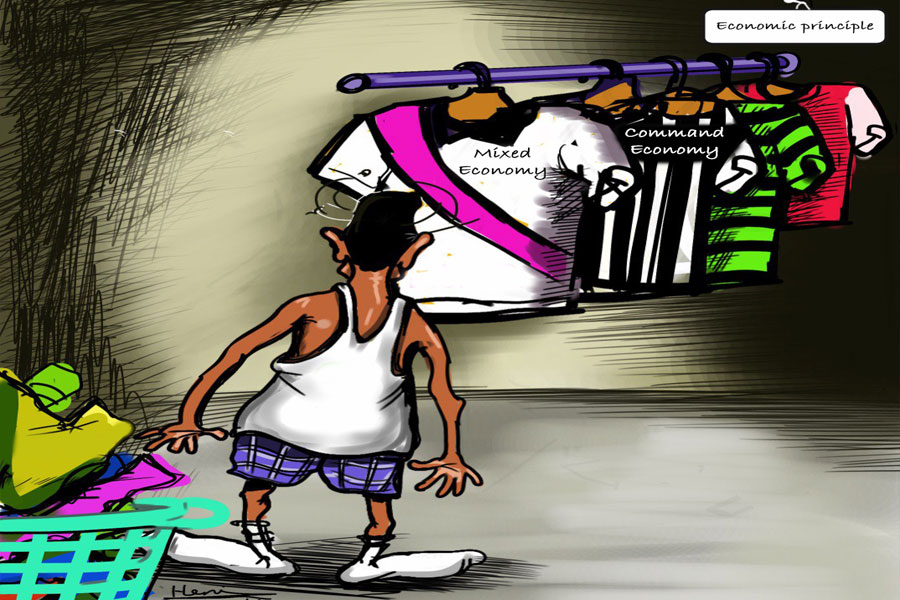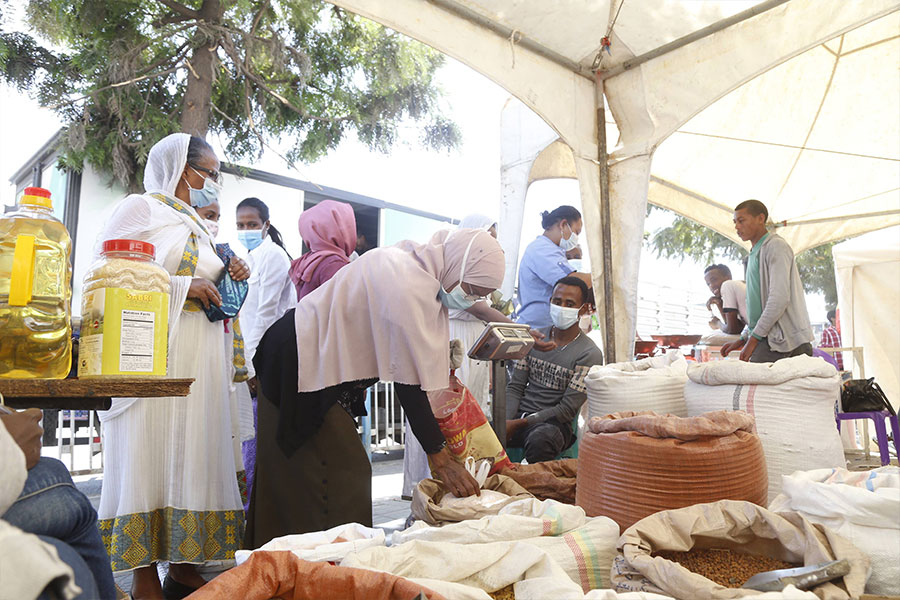
Ethiopia's domestic debt has surged past the 1.2 trillion Br mark, triggering a contentious debate in the federal legislative house. During his nine-month report to Parliament last week, Finance Minister Ahmed Shide faced intense scrutiny from the Standing Committee for Planning, Budget & Finance, which called for attentive management of the mounting debt. Recent data covering a period from 2019/20 to the end of 2022/23 revealed a cautious yet unsurprising uptick in both external and domestic borrowing.
However, the federal government has curtailed direct borrowing from the National Bank of Ethiopia (NBE), seeking alternative financing methods to cover its budget deficit during times of austerity measures and face loan payment defaults to external creditors.
Ethiopia's public sector debt (including its external obligation) crept up slightly in the six months to December 31, reaching 64.3 billion dollars, a moderate 1.63pc increase. The rise represents 39.4pc of the country's nominal Gross Domestic Product (GDP), an essential indicator of the fiscal pressures it faces as the administration of Prime Minister Abiy Ahmed (PhD) struggles to manage a growing debt load.
“The economy is wrestling with the challenges of managing borrowing while maintaining growth momentum,” said a macroeconomist, speaking anonymously.
External debt increased modestly by 1.02pc, while domestic debt rose more pronouncedly by 2.12pc. Despite the escalation, Ethiopia's debt metrics remain within sustainable boundaries as defined for low-income countries. External debt comprises 17.5pc of GDP, comfortably below the cautionary threshold of 40pc.
An internal document from the Ministry of Finance attributed the debt’s sustainability to the government's “careful debt management strategy,” which it argued is supported by consistent economic expansion. The annual growth rate in GDP was 6.2pc last year, a percentage point lower than government authorities claimed. However, the rate of the economy’s expansion has continuously declined since the 2010s when the GDP was growing by double digits, fueled by massive public infrastructure investments mainly financed by external loans from China and multilateral financial institutions, ballooning public debt.
“The government’s debt strategy aligns with broader economic reforms under the Homegrown Economic Reform Program, aiming to enhance macroeconomic stability and encourage private sector involvement,” says the internal document.
Much of the funds procured through public debt has been allocated to infrastructure, energy, and transport sectors.
The composition of the public sector debt includes commitments by the federal government and those guaranteed for state-owned enterprises (SOEs), as well as non-guaranteed debts of public enterprises such as Ethiopian Airlines. A substantial proportion of the public debt is external loans, with major creditors including the World Bank’s International Development Association (IDA).
In 2021, the federal government established the Ethiopian Investment Holding (EIH), a sovereign wealth fund incorporated to manage state assets and generate revenue independently of traditional fiscal mechanisms. The move, along with the establishment of a Capital Market by mid-2021, marked a shift towards diversifying funding sources and reducing reliance on external debt. The federal government has also leveraged innovative financial instruments like Treasury Bills, which have seen an increase in yield, reflecting a rising cost of government borrowing.
“While this strategy expands the domestic debt portfolio, it also attempted to fulfil the dual purpose of financing government projects and cultivating a local investor base,” said a macroeconomist.
The Ministry's report attributed this shift to the Development Bank of Ethiopia (NBE) converting much of its debts to Treasury bills and bonds. Despite making 65 billion Br in payments to service domestic debts, this represented only 40pc of the nine-month target. It has sold 88 billion Br in treasury bills and bonds to cover its 139 billion Br budget deficit.
The Finance Minister attributed the growing reliance on Treasury bills and bonds, which have become mandatory for most commercial banks, to being a preferred choice for financing public debt. Despite these measures, debt servicing costs have reached 40.72 billion Br, with 65pc of this paid, reflecting a rising debt stock to GDP ratio of 40.2pc.
"Our biggest risk is high debt servicing compared to our exports," Ahmed told Parliament, stating the disproportionate burden on the economy.
He hopes that potential debt restructuring under the G-20 common framework mechanism could reduce these high servicing costs and bring debt distress to moderate levels within six years. A critical component of this strategy includes economic reforms, such as a medium-term tax strategy developed with the help of international financial institutions. The debt restructuring deal hinges on adopting an economic reform package prescribed by the International Monetary Fund (IMF), which includes fiscal consolidation, recalibrated balance of payments, tax reform, and addressing disparities between official and parallel foreign exchange rates.
Ahmed praised the interim debt suspension agreement of 1.44 billion dollars from China and ongoing negotiations for nearly half a billion dollars more as noteworthy achievements in managing the external debt burden, which stands at 28 billion dollars.
"The interim relief was a major milestone for our forex management," he said.
However, the negotiated debt service suspensions under the G20 Debt Service Suspension Initiative (DSSI), which provided essential fiscal breathing room, ended last year. New rounds of negotiations with private, bilateral, and multilateral creditors are ongoing, the latest being held in Washington, D.C., in April with the IMF. Neither side has reported a deal, though.
According to Julie Kozack, the IMF's communications director, a final deal has yet to be reported despite signals of "progress" in negotiations.
The federal government's direct borrowing from the central bank has reduced by 90 billion Br from last year to 57 billion Br. The Finance Minister disclosed a shift towards sustainable debt management, pointing to a 200 million dollars reduction from the 8.6 billion dollars owed by state-owned enterprises to external creditors.
Nonetheless, such a shift in policy gear did little to comfort legislators such as Desalegn Wedajo, chairperson of the Standing Committee. He was concerned with the long-term feasibility of shifting to domestic borrowing as a sustainable strategy to address the budget deficit, hitting a record high of four percent of the GDP.
"This could entail risks soon," Desalegn warned.
Economists like Atlaw Alemu (PhD) stressed balancing aspirations for tight budgetary control with expenditure prioritisation. He warned against cutting essential public services like education and health while allocating funds to unproductive sectors, particularly under an austere monetary policy.
"Budget deficit financing should not cost the economy's long-term productivity," Atlaw told Fortune.
The central bank's December quarterly report revealed a 26.6pc expansion in broad money supply due to an equivalent increase in domestic credit, offsetting a 43.3pc contraction in external net assets. The Minister acknowledged the need to improve dividend collection from state-owned enterprises (SOEs), as only 27pc of the 2.3 billion Br target was met. The Liability & Asset Management Corporation (LAMC), incorporated to absorb the financial burdens of highly indebted SOEs, has struggled to secure adequate financing.
Finance Minister Ahmed pledged to legislators that no lines of credit would be extended from the state-owned Commercial Bank of Ethiopia (CBE), where he sits as a board chairperson, to SOEs without demonstrable proof of viability in new projects.
Habtamu Hailemichael is a director general of the Public Enterprises Holding & Administration (PEHA), a federal agency overseeing nine SOEs expected to make five billion Birr in dividend payments last year. According to him, funds were held up due to administrative expenses and investment, not an inability to pay. Enterprises like the DBE have restructured their management to reduce high levels of non-performing loans (NPLs) and manage fresh disbursements more effectively.
"Some did not have adequate liquidity," said Habtamu, referring to the Industrial Park Development Corporation (IPDC).
The remaining 27 SOEs, including Ethio telecom, under the EIH, are expected to partially privatise, floating 10pc of their ownership stake to the public.
The Finance Ministry has finalised budget ceilings for 167 federal ministries, marked by tight allocations to reduce inflation to single digits within two years. These measures include austerity steps like halting new large projects, reducing subsidies, and blocking some payments. State Minister for Finance Eyob Tekalegn (PhD) urged lawmakers to speed up a bill before Parliament to legislate compensation payments for right-of-way claims in development projects.
"We've no plans to make all the payments," Eyob disclosed, addressing controversial right-of-way issues at regional-state levels and advocating for them to self-administer expenses through new legislation.
The Finance Minister urged Parliament that right-of-way compensation laws need revision due to the frequent construction of 'artificial homes' in anticipation of federal road projects in regional states.
"We are working to ensure a resilient public finance framework," he said.
Wondwessen Admase (MP) challenged this, pointing out that communities have been stranded for up to a decade without compensation after being resettled for development projects. Nearly 13 billion Br in compensation claims have accrued under the Ethiopian Roads Administration (ERA), leading to project bottlenecks and delays.
"What will be the fate of these people?" Wondwessen enquired. "It's not like a new law can be enforced retrospectively."
Legislators like Debebe Admasu echoed concerns about public expenditure control. He questioned the underfunded food budgets for university students and the unspent 20 billion Br set aside to rehabilitate war-stricken areas for a second year. The Finance Minister acknowledged the need to revise the daily food expenditure estimate for university students, currently at 20 Br, and noted that part of the 20 billion Br budget was spent on the Rehabilitation Commission's efforts in Disarmament Demobilization Reintegration (DDR).
Ahmed told Parliament of the difficulties in administering humanitarian assistance and post-conflict rehabilitation due to ongoing security issues in parts of the country, which impede projects requiring foreign currency payments.
"Ensuring the rule of law nationwide is crucial to raising government revenue," he said.
Atlaw cautioned that as long as the economy's productivity remains constrained, the government will continue to compete for available credit with the private sector or rely on newly printed money, restricting potential tax revenue. By increasing the supply of goods, a productive private sector can address inflationary pressures while boosting disposable income through employment, savings, and investment.
"A credit-starved private sector might worsen the macroeconomic instabilities," Atlaw warned.
He also noted that if the broad and narrow money supplies continue to grow without an equivalent increase in productivity, efforts to reduce inflationary pressures would make little headway.
Resource mobilisation efforts are ongoing, and the Finance Minister disclosed that the conflicts' impact in the Tigray, Amhara, Oromia, and Afar regional states is being rigorously assessed.
"There were areas left out from the damage assessment," Ahmed said.
PUBLISHED ON
[ VOL
, NO
]

Fortune News | Feb 26,2022

Sunday with Eden | Jun 08,2024

Viewpoints | Dec 26,2020

Fortune News | Dec 25,2021

Editorial | Apr 09,2023

Fortune News | Feb 18,2024

Fortune News | Oct 23,2021

Commentaries | May 03,2025

Editorial | Mar 16,2024

Agenda |

Dec 22 , 2024 . By TIZITA SHEWAFERAW
Charged with transforming colossal state-owned enterprises into modern and competitiv...

Aug 18 , 2024 . By AKSAH ITALO
Although predictable Yonas Zerihun's job in the ride-hailing service is not immune to...

Jul 28 , 2024 . By TIZITA SHEWAFERAW
Unhabitual, perhaps too many, Samuel Gebreyohannes, 38, used to occasionally enjoy a couple of beers at breakfast. However, he recently swit...

Jul 13 , 2024 . By AKSAH ITALO
Investors who rely on tractors, trucks, and field vehicles for commuting, transporting commodities, and f...

Jun 28 , 2025
Meseret Damtie, the assertive auditor general, has never been shy about naming names...

Jun 21 , 2025
A well-worn adage says, “Budget is not destiny, but it is direction.” Examining t...

Jun 14 , 2025
Yet again, the Horn of Africa is bracing for trouble. A region already frayed by wars...

Jun 7 , 2025
Few promises shine brighter in Addis Abeba than the pledge of a roof for every family...